WEEKLY INTAKE - 15. 2025
LIFE ON K2-18B. ANDREJ KARPATHY. PALMER LUCKEY. COACHELLA. MILLENNIAL SUBSIDY. TRADE WAR SOCIAL PSYOPS. HERMES SURPASSES LVMH (BRIEFLY). RAY BAN’S REBRAND. ORIGINAL FILMS FLOPPING. PANIC BOOM.
I write this week from Syracuse University, my alma matter.
I’ve been spending time with the students at New House which is one of the best schools in the country for those interested in entertainment, television, radio & film.
Returning to a place that was formative to a certain part of my life, but having not been here for 20 years is surreal, what felt substantial then, is a BLIP.
Two insights stood out across portfolio reviews and questions at the end of my talk:
This generation is deeply concerned with sustainability.
About 80% of student portfolios included projects with environmental angles, from carbon-removing fabrics to solutions for coffee waste—a stark contrast to my college years when these weren't central conversations. Its beautiful and sad simultaneously to see how much this generation thinks about this.
AI was trepidatiously questioned, almost like a dirty word.
This is interesting because we’ll see some schools embracing it and others discouraging it. Universities are split, with 60% integrating AI tools in curricula (Source: Educause 2024).
I emphasized that AI is the most disruptive force they’ll face in their careers. There's really only one approach: embrace it, learn it deeply, or get left behind
I understand the counterpoint, or fear that AI risks diminishing critical thinking or originality, however it is a TOOL in a part of the process. Digital cameras, Serato, and photoshop are similar in their impacts to creative fields.
Recently universities have been about 10% of my time. Going right to the source has been amazing for recruitment. Its invigorating to be around students, they’re not jaded and sometimes bring questions that leave me thinking days after. It’s way to get this generation knowing about our business as a place to start their career.
LIFE ON K2-18B
As a space nerd and ‘future optimist’, waking up to breaking news from the NYT validating potential life discovered on a distant planet, was a welcome relief from the current news cycle.
“This is a revolutionary moment, It’s the first time humanity has seen potential biosignatures on a habitable planet.”
- Nikku Madhusudhan, an astronomer at the University of Cambridge.
Astronomers studying K2-18b (discovered in 2015) have found molecules typically produced on Earth only by organisms like marine plankton. The James Webb Telescope, launched in 2021, enabled deeper composition analysis, revealing tremendous dimethyl sulfide quantities—indicating the planet could have large oceans teeming with life.
Madhusudhan believes confirmation is possible within two years, with current data at 99.7% accuracy (scientific consensus requires 99.99999% or "five sigma"). He notes: "If we confirm life on K2-18b, it should basically confirm that life is very common in the galaxy."
The planet is massive, approximately 2.6 times the radius of Earth and about 8.6 times its mass. It is however, very far away. 700 trillion miles, or 124 light years, a distance we cannot currently travel in a lifetime. Good thing were making progress with cryogenically freezing people.
TWO GREAT EPISODES OF TETRAGRAMMATON
Back to back fascinating conversations.
One with Aravind Srinivas co-founder and CEO Perplexity AI, the other with Palmer Luckey. I love Rick’s curation because it’s given me insight into people who I have a tertiary but not deep understanding of. His conversations really bring them out.
I found his conversation with Shane Smith of Vice great in a similar fashion. Thinking I ‘knew the vice story’ vs really understanding that guy and what he was all about.
Starting with Perplexity. (Full episode link)
A little dense, but a great primer on the AI landscape, where we’re going and how we got here. Ruben is a great host as he asks questions which really force complex things to be simplified while allowing for depth in the answers.
Perplexity is a hybrid between advanced AI chatbots and traditional search engines. It’s big differentiator being that it’s programmed to provide sources for ALL answers, seeking accurate, verifiable, and current information in a conversational format.
Perplexity seems to be positioning itself as the ‘Thinkers AI’
‘Vibe coding’ and its impact. An extremely recent development, first used in February 2025 by Andrej Karpathy, the simplest explanation being it’s enabling ordinary people to create software without deep technical knowledge. NYT has a great article on it.
Until now, many people didn’t have the patience for coding because of bug checking and how cumbersome that is (something LMM’s are perfectly equipped to take on quickly).
Allowing anyone to code will open up creation for the individual vs the masses. Were entering an era of “Software for one”, personalized AI-generated tools designed to address specific individual needs.
Ruben makes analogy to the Auteur era of film, when the director, rather than the studio, took on a key authorial role.
The prior app building era was constrained by its complexity, cost to build and the need to sell to as many people as possible. When you build something for so many people it becomes the common pattern, unique things don’t make it through the scale filter. The first version of any great application 90% of people would say they don’t need.
Andrej put a question forth that really stuck with me;
As work gets automated, will people stop asking questions? Or will we get lazier?
Palmer Luckey (Full episode link)
This one moves at a better pace. Palmer has a lot of energy, as a mechanic by origin, he explains a lot of his inventions and feats in a very understandable way. The first half focuses on the VR era of his career while the second focuses on what he’s doing with Anduril, attacking the cost plus waste of our current military tech industry.
Science fiction drives the future.
Books and films have outsized impact on the minds of people like palmer, they pull things from those realms into our reality. He talks about his time with BraveMind, a collaboration between Hollywood and the military as an example. There is a division called ICT (Institute for Creative Technologies) that directly employs Hollywood filmmakers, game developers, and visual effects artists to develop military tools. Iron Man and the TALOS Exosuit would be a prime example of something fantastical now being developed for real.
FAILED TECHNOLOGIES
Certain technological pursuits seem "forever in the future" Technologies that, despite early promise, face significant technical, economic, or social barriers, until breakthroughs occur.
VR, Genetic engineering, Nuclear Fusion, Flying Cars and AI all have all faced repeated cycles of hype, investment, and disappointment. These are pursuits which have ruined careers and credibility for many people. VR failed in the 90’s so knowledge was lost. There are very little books or analysis of failed products. Compared to the iPhone which has ample knowledge and hundreds of books covering it because it was a success.
What’s interesting is we’re seeing significant breakthroughs in all of these industries simultaneously, after 60 years of stagnation.
Palmer talks about entering VR through the eyes of a gamer, seeing it as the ‘End state’ of the ideal game experience. I love how he approaches problems from the end goal, where technology will be in 20, 100 years, ignoring the messy middle.
ON CREATOR VS CONSUMER MENTALITY
I related to their conversation around being an obsessive person, how that is good for accomplishment but often misunderstood. Palmer talks about “creator vs consumer mentality” where the majority of people don’t understand a desire to create not for money but for the path of creation itself.
He doesn’t have to work, becoming a billionaire from selling Oculus to Meta in 2014 for approximately $2.3 billion in cash and stock.
Why start another business, one as HARD as disrupting the entrenched military industrial complex? At this point its pure passion and a love of solving problems. He states the idea is not just to make money but to Kill legacy problems.
Some people look at people like that and think ‘you’re a workaholic’.
The purest and most financially illogical example of this is his ModRetro Game Boy. He’s reviving a dead technology, in the BEST way possible with no expenses spared or real consideration for a commercially viable product. From a magnesium alloy chassis, to lab-grown sapphire crystal screen covers, its a passion project pursuing perfection for the sake of perfection.
Other interesting aspects from the convo:
Non implant neural tech will come, bracelets currently exist that can process neural communication.
Skill ceiling technology - A gaming term, when applied to technology at large, refers to the upper limit of expertise required to fully utilize or master a system. An Iphone for example has a LOW ceiling, meaning by design, it can be understood and mastered in a matter of minutes. Palmer is most interested in HIGH ceiling technology, that could take thousands of hours to master, but exponentially improve human output.
He is the embodiment of the manufacturing argument. Everything Anduril makes for the United States they make IN the United States. It’s really hard to not use China but critical to our national security. He believes we can manufacture again.
Smart kids are going to where economic opportunities are, there are not enough incentives to become a manufacturing engineer. The people who know how this shit works are old and were in danger of a loss of knowledge.
Things are always changing.
We’ve gone from Pearl Harbor to selling Japan f-35’s in a lifetime.
Peace through strength.
‘Some problems take decades to create and they take decades to fix’
COACHELLA
Coachella has always been a trend indicator, for a long time I’ve paid more attention to brand activations, who’s showing up and spending over the line up. An alarming trend emerged this year, with 60% of general admission packaging purchased using buy now pay later.
The barrier of entry for live performances has gone through the roof, and promotors have adjusted tactics, marketing cheep $20 entry points with a ‘you can afford this, but need to act quickly’ approach. Ticket buyers are charged a $41 fee for using Coachella's payment plan which amounts to about 8% of the total cost. It’s also helping hedge pre line up sales, as the plans start with 3 monthly payments prior to line up announcement.
This buy now pay later boom reflects Gen-z’s nihilistic, YOLO view of saving and a shift towards experiences and instant gratification over necessities or investing. A major component is FOMO-driven as well, with social media’s flex culture creating pressure to attend.
FESTIVAL FATIGUE
Usually Coachella is a barometer of the late stage of trends, being a late stage trend itself. Generally there is festival fatigue. Similar to burning man, Coachella has felt played out for a while.
After peaking in 2018, search queries for festivals have progressively declined year over year, accelerating post pandemic. 2024 was the slowest sales in a decade for Coachella, the first time in 11 years the festival didn’t sell out both weekends.
Over corporatization and the plethora of brand houses have coined Coachella as the ‘Influencer olympics’ or ‘cultural desert’ ultimately killing the vibe.
Live music at large is booming though, live nation reported its best year ever in 2024. Concert attendance is at an all-time high, led by tours from Oasis, The Rolling Stones, Bruce Springsteen, Bad Bunny, and Taylor Swift.
TOP PERFORMING BRANDS
With Coachella now being all about ‘earned media value’ its still a place where brands place large bets with their marketing budgets.
BOF’s ‘Who Won Coachella’ brand report digs in. Unsurprisingly Rhode & Revolve top the lists. The same week, Revolve was hit with a $50M Lawsuit over ‘undisclosed influencer deals’, impeccable timing.
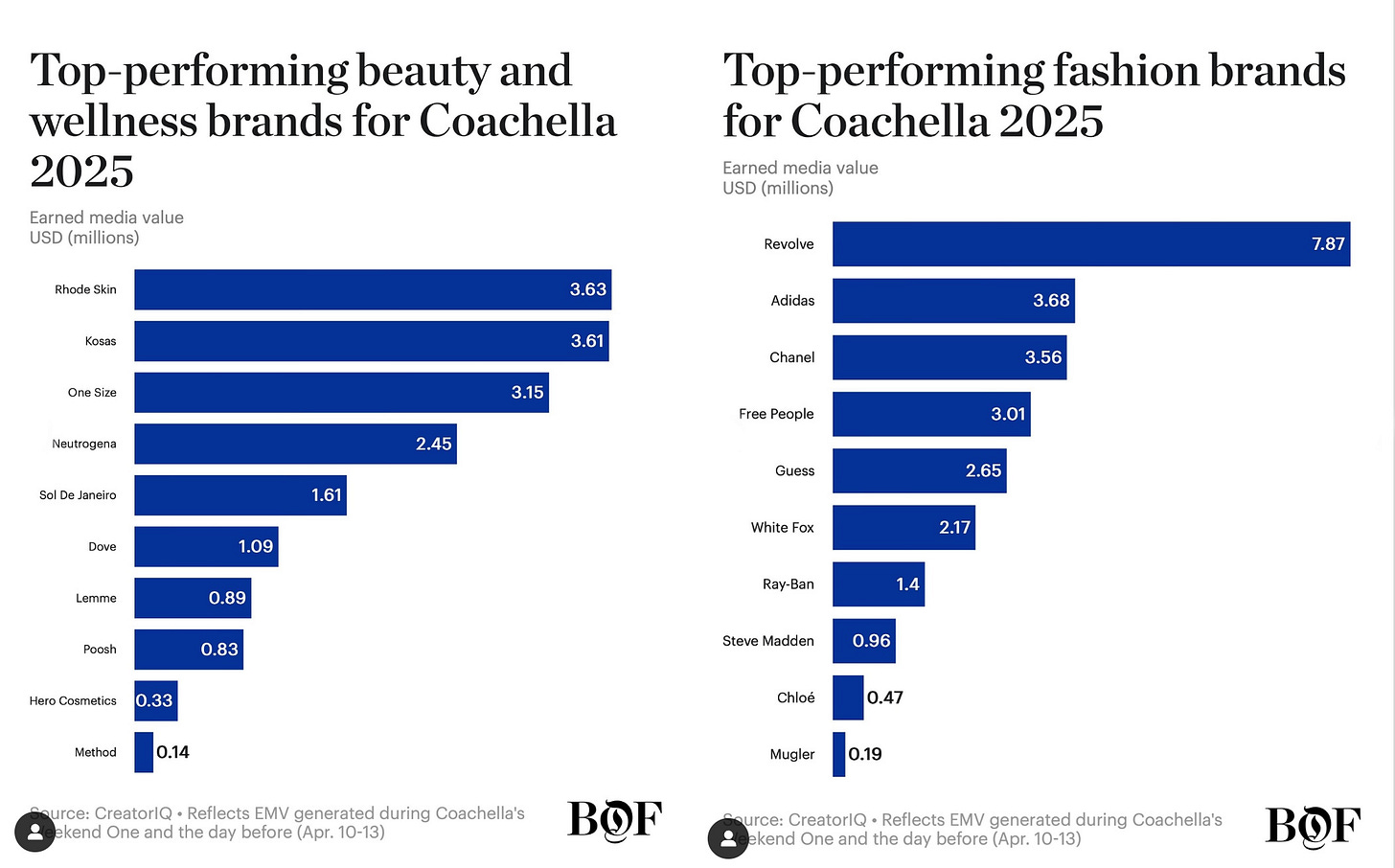
Travis scott built a entire brand world with Nike, Rick Owens, Vetements, Fox Racing, and Erewhon. A full 1.5 acre build with a Nike cage tournament, is the pinnacle of artist and brand activation.
MILLENNIAL LIFESTYLE SUBSIDY
We’ve gotten used to nice things.
From 2012 to early 2020, we enjoyed lifestyle benefits from cheap rides, food delivery and Airbnb’s disruption of the hotel industry. The problem is none of it was grounded in reality. Venture backing allowed all of these platforms to provide services heavily discounted while operating at a loss to capture users, prioritizing growth over profit.
A subsidized lifestyle for younger consumers in an app-driven climate of low interest rates and free flowing investor capital is unwinding. Derek Thompson first coined this with an Atlantic article in 2022.
“Today my Uber ride from Midtown to JFK cost me as much as my flight from JFK to SFO,”
-Sunny Madra . Vice president at Ford’s venture incubator.
Interest rates have risen and capital has dried up, these companies are now under pressure to become profitable, passing the costs to the consumer.
Anyone who’s used an Uber lately knows the party is over.
The sticker shock is real, Uber rides have jumped 40% if now more, and Airbnb rates increased around 35% with a lot less availability due to many short term rentals failing. This hits a particularly sensitive time as millennials and younger generations face wage stagnation and increased cost of living across the board.
The ire here comes from a percieved bait-and-switch, with most unaware these services were losing billions to provide artificially low prices.
Is this a return to realistic market economics or will the tech industry lose customers unable to afford higher prices?
LUXURY MARGINS AND TRADE WAR SOCIAL PSYOPS
Last week it was AI generated obese Americans in factories, this week China has been pumping out ‘wholesaler exposure’ videos breaking down exactly where luxury products are made and how much they actually cost.
TikTok user @lunasourcingchina has been racking up millions of views in days by sharing the names of factories they claim supply western brands.
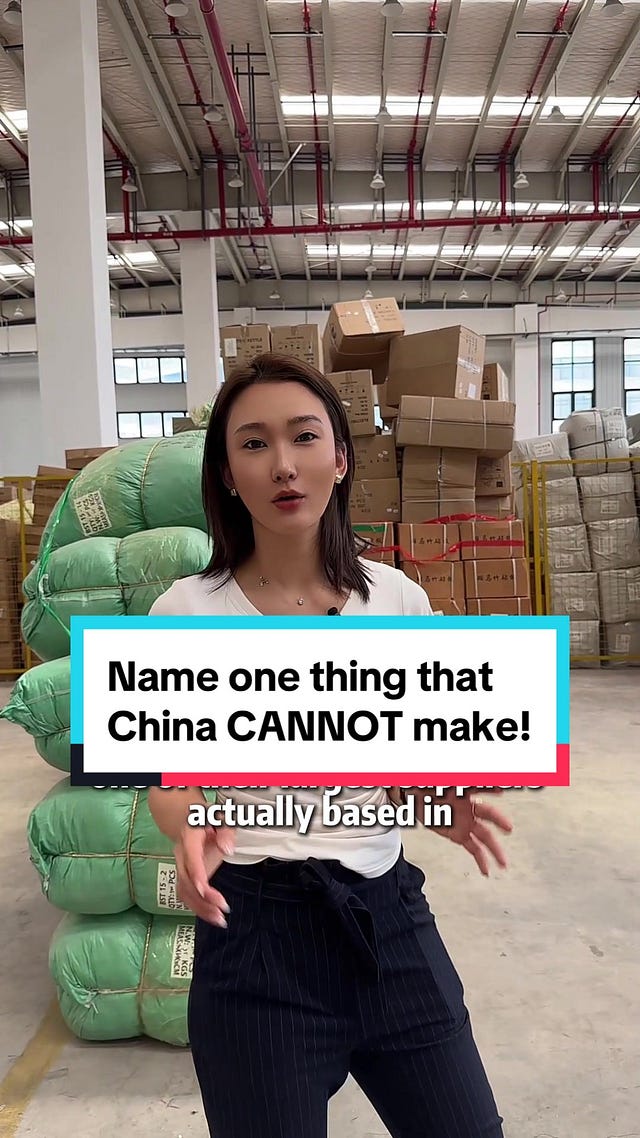
 Tiktok failed to load.
Tiktok failed to load.Enable 3rd party cookies or use another browser
(interestingly the first video disappeared after a week)
DHgate, a niche wholesale platform for sourcing inexpensive goods, saw a massive spike in traffic after these videos made rounds, rising to #2 in the US App Store charts last week.
Its been an unspoken truth that most luxury products are mass produced in china, then shipped to a place of ‘origin’ to get minor tweaks in Europe and be labeled ‘Made in France’ or ‘Made in Italy’.
One video alleges that a $34,000 Birkin only costs $1,400 to produce, as if that was surprising to anyone. Birkins are expensive for different reasons, because of the waiting list, the tightly controlled amount per year released into the wild etc.
This reminds me of the final scene of blood diamond where the coveted stone is simply placed in a De Beers vault in London never to see the light of day.
According to McKinsey’s 2025 State of Fashion report one in three North American adults intentionally bought a dupe of a premium or luxury product with half buying it for cost savings.
All of this feels very politically charged, last weeks factory memes, now Tiktok’s algorithm pushing these videos to virtually everyone simultaneously.
Social content warfare is heating up.
The Verge, has a great piece on all of this.
HERMES SURPASSES LVMH IN MARKET CAP (BRIEFLY)
LVMH shares dropped 7% last week, allowing Hermes to briefly take its slot as the largest luxury company by market cap.
LVMH is more prone to factors such as a slowing consumption of beauty products, and the liquor side of their business, specifically cognac declines in China. They have to pay attention to the middle and aspirational consumer.
Hermes is purely focused on a wealthier client base at the highest end, with continued demand even as they plan to pass tariff hikes to clients with new increased prices. There is no aspirational Hermes consumer.
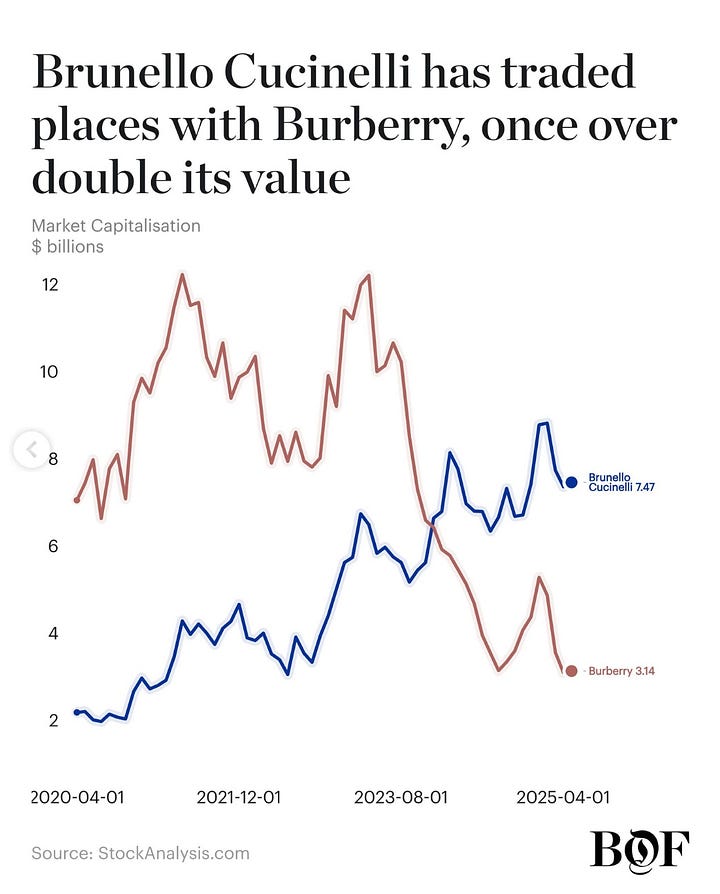
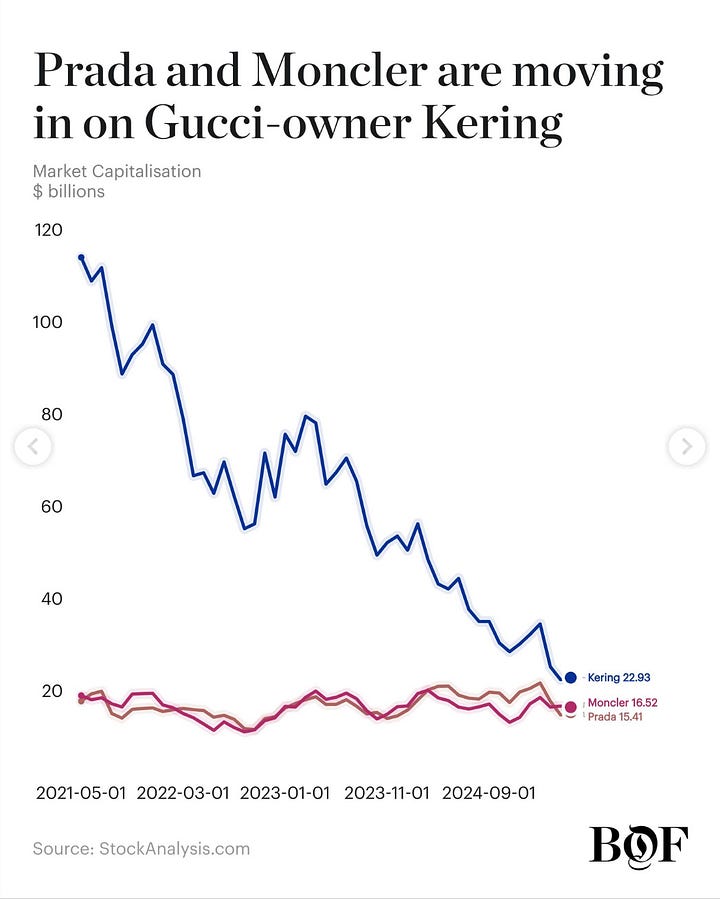
Other key developments playing out across a shifting luxury fashion landscape:
Kerring’s significant decline, now in range of Prada & Moncler.
Burberry, once twice the value of Brunco Cucinelli trading places.
FRITZ HORSTMAN | RAKING LIGHT
Fritz Horstman’s exhibition Raking Light will be at Planthouse through mid may.
The exhibit will showcase Horstman’s Folded Cyanotypes series. Created by folding cyanotype-coated paper, exposing it to sunlight, and then flattening it. Areas touched by light develop into vivid blue, while untouched sections remain white. Its playing with sculptural elements, printmaking and camera-less photography simultaneously.
Fritz Horstman | Raking LightApril 10 – May 17, 2025.
Planthouse 55 W 28th St
New York
ANDERSON RANCH SUMMER SERIES
Cultured Magazine partners with Anderson Ranch for a second season of 'The Summer Series’ with curation by Sarah Harrelson. Running from July 9th through August 7, free and open to the public, it creates a perfect reason to see the rockies in the summer.
The series starts with a conversation between Titus Kaphar, and actor Andre Holland. Titus also receives Anderson Ranch Arts Center's International Artist Award this year, joining past recipients including Theaster Gates, Wangechi Mutu, Ai Weiwei, and more.
Founded in 1966, Anderson Ranch Arts Center in Aspen/Snowmass, Colorado, is an artist community offering classes, residencies and programing centered around critical dialogue.
A24 LAUNCHES MUSIC
Always with a good retro blur, RGB split, or cryptic marketing campaign. A24 has launched a new social channel for its music division.
RAY BAN’S REBRAND
We do a weekly creative team meet where as a department everyone shares what’s getting their attention. Last week Ray Ban’s rebrand was leaving an impression.
Its hitting on a few fronts, from technology (meta glasses); to culturally, landing A$AP Rocky as their first ever creative director, to purely aesthetics with the evolution of the Icons campaign.
The campaign work, by Filippo Vezzali and Fedra Malara is sharp, doing a great job of keeping the 95 year old brand fresh. It helps when the product is timeless. They’ve done a good job of not deviating there.

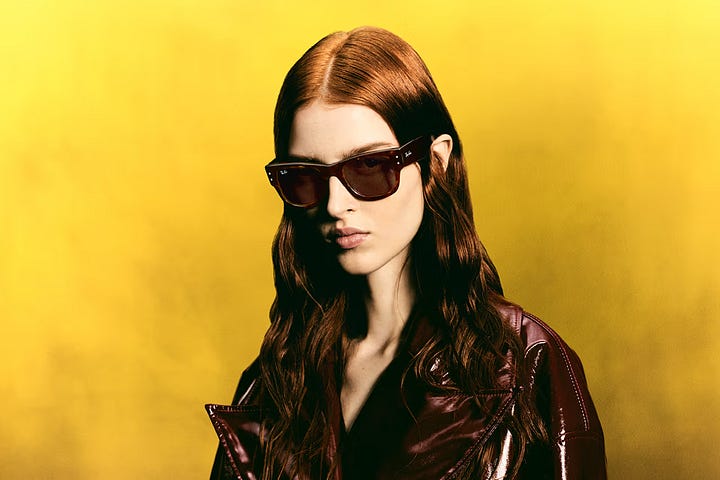
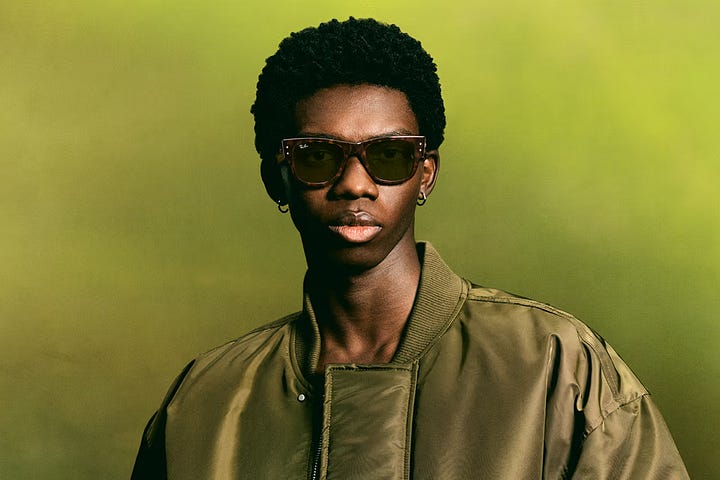

The unexpected landing the plane with meta glasses, something google tried and failed years ago with glass. The key here is ray ban leading product and meta bringing the tech. The shape is good, its not too clunky or weird, it just looks like a pair of chunky glasses which is on trend right now. The quality of the capture is really impressive, its 12mp with stabilization.
I’m seeing great examples of first person experiences. One of my favorites was director/creative Nadia Lee Cohen and Coperni out of paris fashion week (see below). Right now AR really is the most applicable vs VR, it has way more use cases in real life.
We got a few of these for our films department as I think it gives a really personal yet high quality angle to weave into live capture.
Adding to the streak is Rocky’s debut of the ‘Blacked Out’ collection, which dropped last week, reimagining the three most popular silhouettes.
A RETURN TO CLASSICS
The best era of hip hop is having a massive resurgence.
Legend Has It… Will include projects from Nas & DJ Premier, Ghostface Killah’s much anticipated Supreme Clientelle 2, Mobb Deep, Raekwon The Chef, Big L, De La Soul, and one ‘epic surprise guest’.
We’ll also get Nas - Illmatic: Live orchestra. Arguably the best hip hop album of all time will be performed with the GRAMMY Award–winning Philadelphia Orchestra at the TD Pavilion at the Mann.
July 25th. Doors 6pm - Show 8pm.
A new CLIPSE album on the way after 15 years. Pusha T & swizz beats and Jadakiss just dropped Danger Danger (Official Music Video).
THE SELF INFLICTED DECLINE OF LOS ANGELES PRODUCTION
Its become untenable. Ironically Hollywood, the mecca of entertainment, is now one of the most expensive and difficult places to actually produce.
LA film and commercial production has been slowing since 2019, seeing a 39% decline in commercial shooting days in just five years. This year, January through March saw losses in every category of production compared to last year. Soundstages are also at historic low levels of occupancy.
Industry claims covid, writers strikes and wildfires as the culprits but much of this harm is self inflicted.
Simply put, it’s too expensive and complicated to produce in LA, with new markets now competing for production with tax incentives and seeing talent re-locating elsewhere permanently. Permitting in LA is also a nightmare; complex, unpredictable and costly.
Ben Affleck just spoke out about this directly at the premier of the accountant 2:
Other markets have taken advantage. Major talent has MOVED and built production hubs elsewhere. Danny McBride left Hollywood to build his dream production studio in Charleston, South Carolina. 50 cent has built massive production facilities, launching G-unit studios in Louisiana. Atlanta has become a production hub with Tyler Perry Studios and Pinewood Studios (which has seen most of Marvel’s production), attracting significant talent to the city.
For LA to maintain its epicenter of entertainment status, it needs to become more production friendly.
SADLY. ORIGINAL FILMS ARE FLOPPING
This one pains me, as we finally got a run of directors taking risks with studios making bets on new ideas, only to have them flop. For years we’ve been complaining about hollywoods unoriginal franchise factory, and regurgitation of remakes, unfortunately that safety works.
Box offices have been fighting a slow return post pandemic, with the first three months of this year being the slowest since 1996. With people making more frugal decisions, pulling them to movies they have zero awareness of is a real challenge.
Movies that ARE succeeding have IP’s with existing fanbases, like the Minecraft movie which grossed more than $280 million domestically despite poor reviews.
Theres a reason studios only want to make sequels:
Apple and Netflix could step up to the plate here, as they continue to take bets looking to develop new franchises. Apples “F1,” with a massive production budget, Brad Pitt and attachment to the fastest growing sport, is a glimmer of hope for new IP.
PANIC INDUSRTY
People have been prepping for end times since forever, but its mostly been a fringe percentage. As a 90’s kid living in a Dawson’s creek era, ignorance was bliss. End time scenarios simply were not part of the media cycle, there was the one kid who’s family was prepping into y2k being a butt of jokes, but for the most part people weren’t buying bunkers. No longer, the booming panic industry is now worthy of a NYT feature.
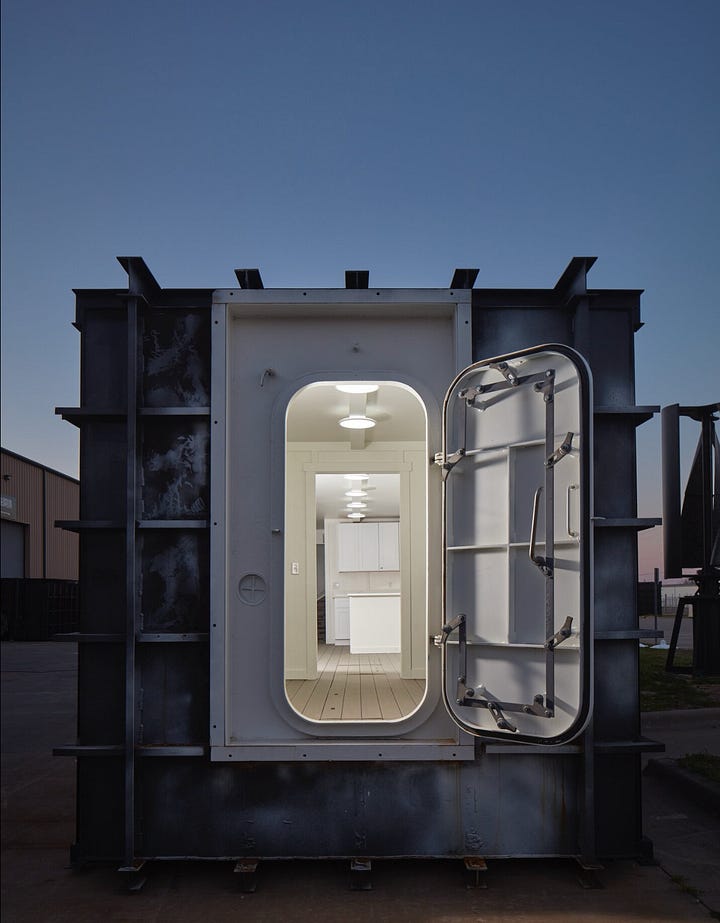
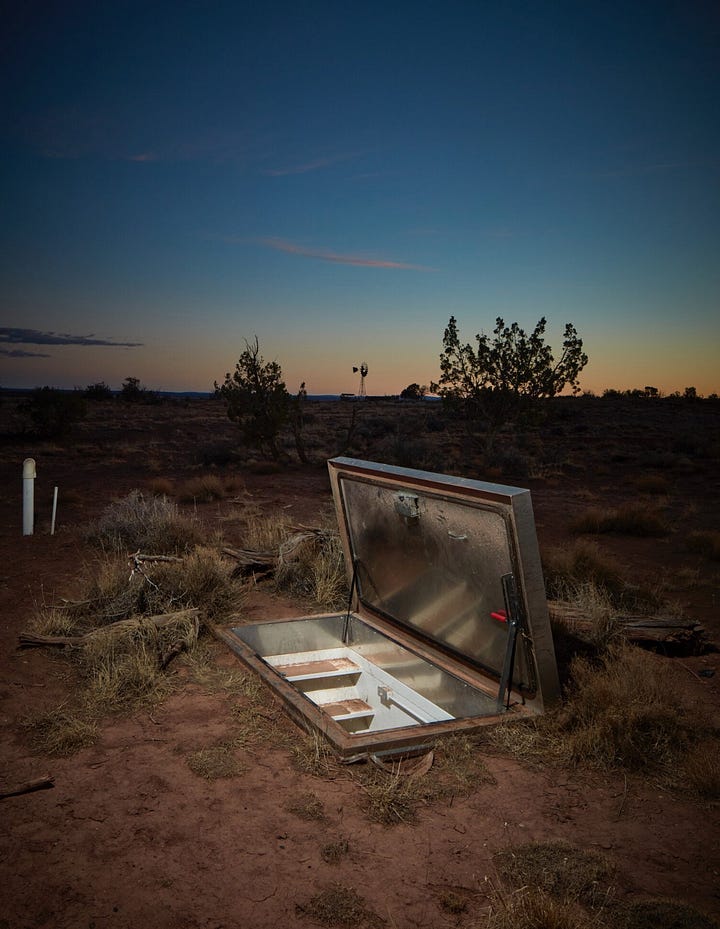
A 2023 survey found that about one-third of American adults were prepping for a doomsday scenario, spending a collective $11 billion over 12 months.
-NYT
Escape routes, arms stockpiling, underground bunkers and flammable moats are now big business. It started with the billionaires, building apocalypse havens in new New Zealand (Although Peter Thiel’s plans were thwarted), Hawaii (Zuckerberg’s secret compound) and other remote areas within charter range of silicone valley, but it has grown much more mainstream.
Now many working class people are looking to buy bunkers. Atlas Survival Shelters sells a $20,000 bunker, targeting “Guys who make 60k a year and drive Chevy pickups, not Ferraris”
Vivos group, has converted a former munitions depot in South Dakota. 575 storage units are now bunkers for lease with $55,000 deposit and annual fee of $1,091. This at least feels like a post apocalyptic community as you’ll actually have ‘neighbors’
Creative home engineering (makers of concealed rooms and passageways) claims concealed gun ranges are one of their most common installations.
SAFE on the higher end of the spectrum, with projects starting at $10m going to over $100m is the real preppers fantasy. State of the art air raid shelters, nuclear proof, Residential medical suites, all the goodies.
I remember this story on vice with media theorist Douglas Rushkoff , he was invited to a tech conference to speak about the digital future, thinking he’d be speaking in front of hundreds. Instead was brought to a green room and joined by 5 people who paid for the conference, peppering him with questions on how to best navigate impending civil collapse. That conversation WAS the conference.
“The most powerful people in the world see themselves as utterly incapable of actually creating a future in which everything’s gonna be OK.”
–Douglas Rushkoff
THIS WEEKS PAINTING
A Koi Revisited.
In the spirit of continued evolution, I recently revisited a piece that had not been sitting right with me. Part of a ‘Koi’ Series, it felt constrained with nothing really breaking the boundary of the frame.
To fully paint over something is cathartic, in this case the piece took on an entirely new energy. I’m happier with the new, it has a greater sense of depth.
More of my life and process here.
- Thats it for this week

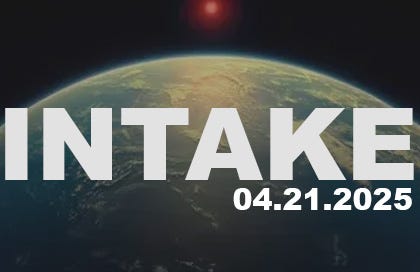


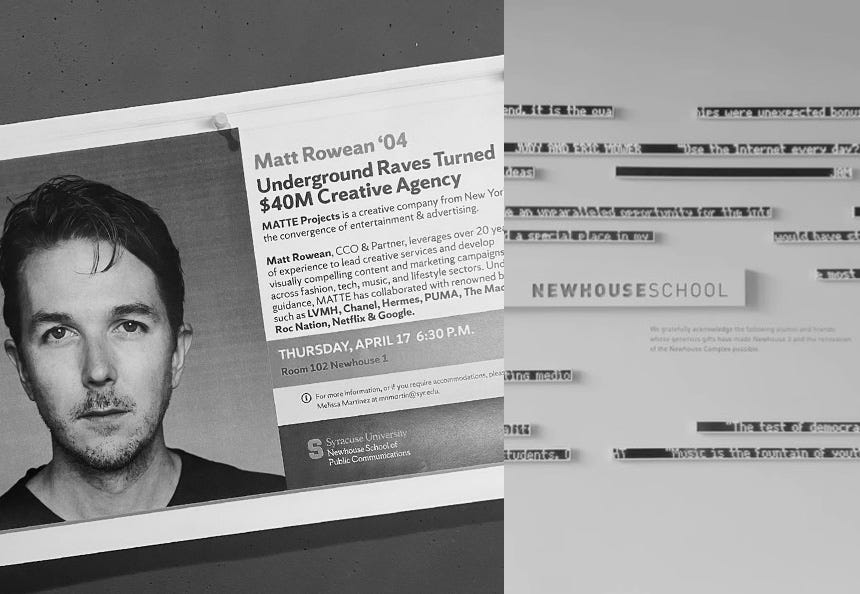
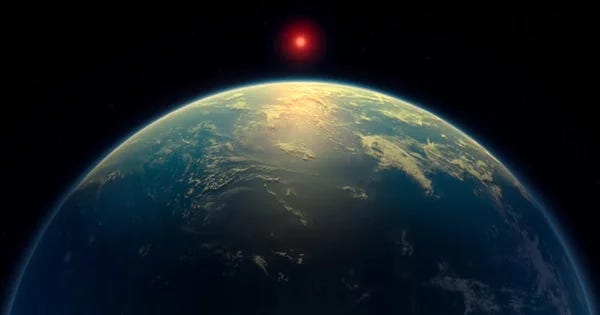
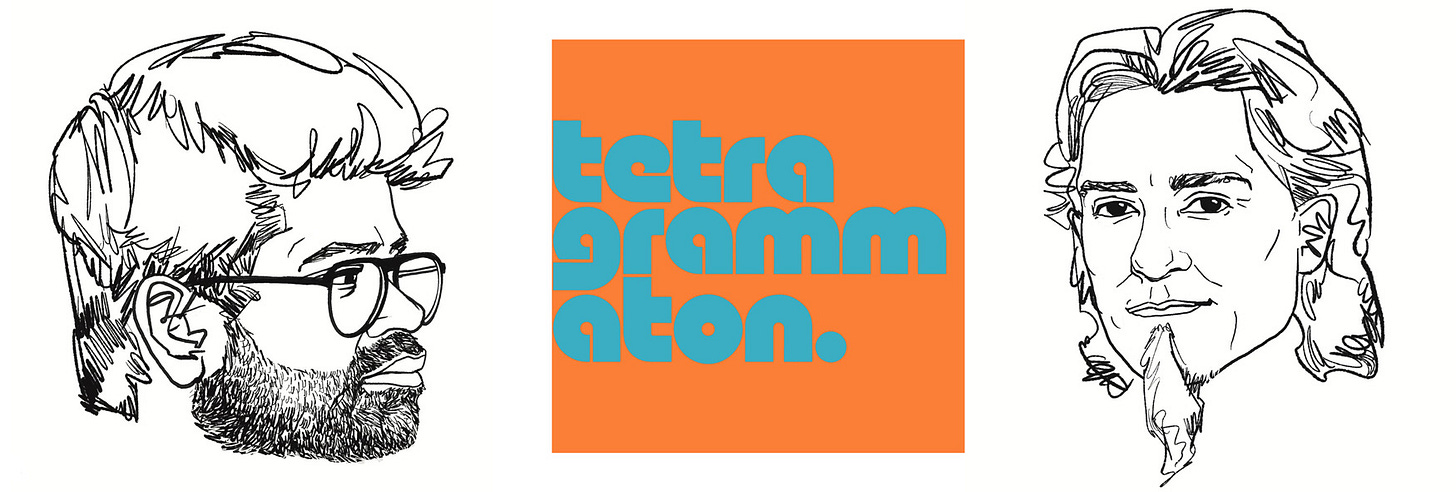
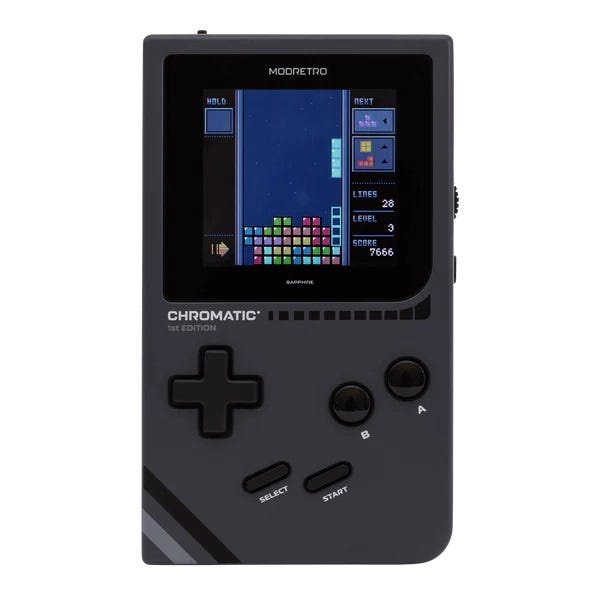
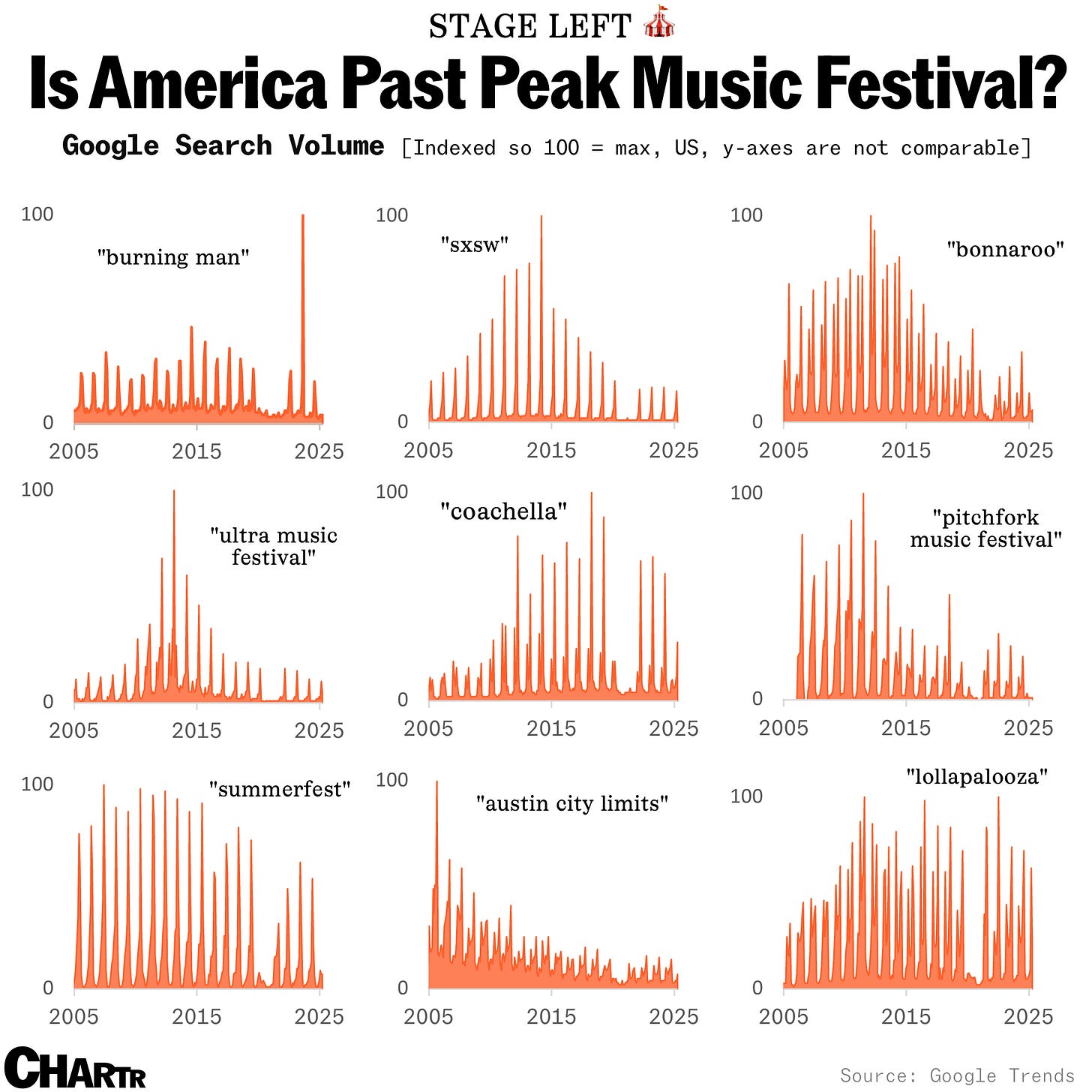

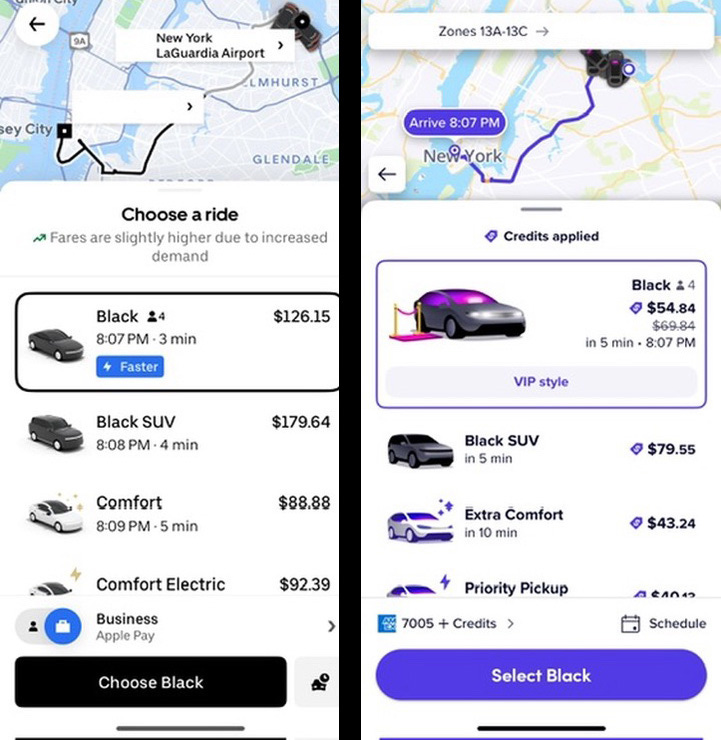
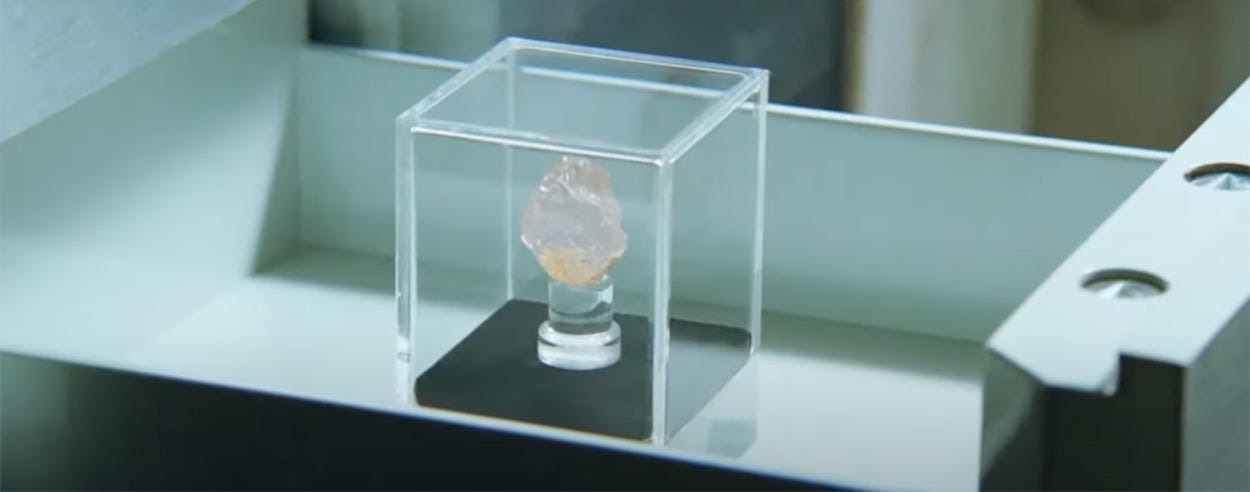


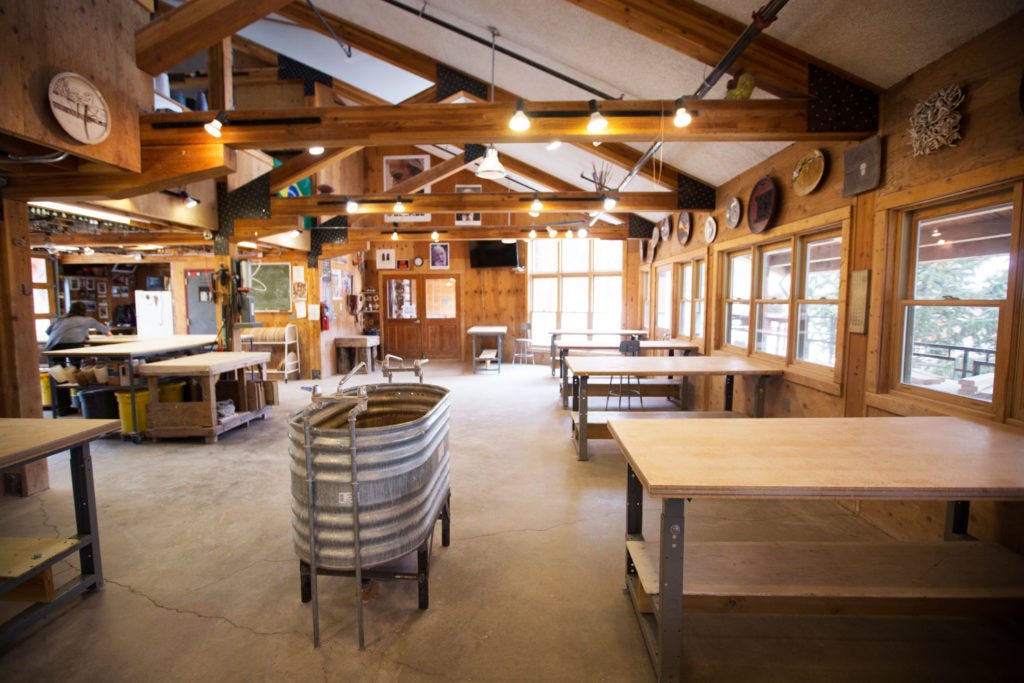
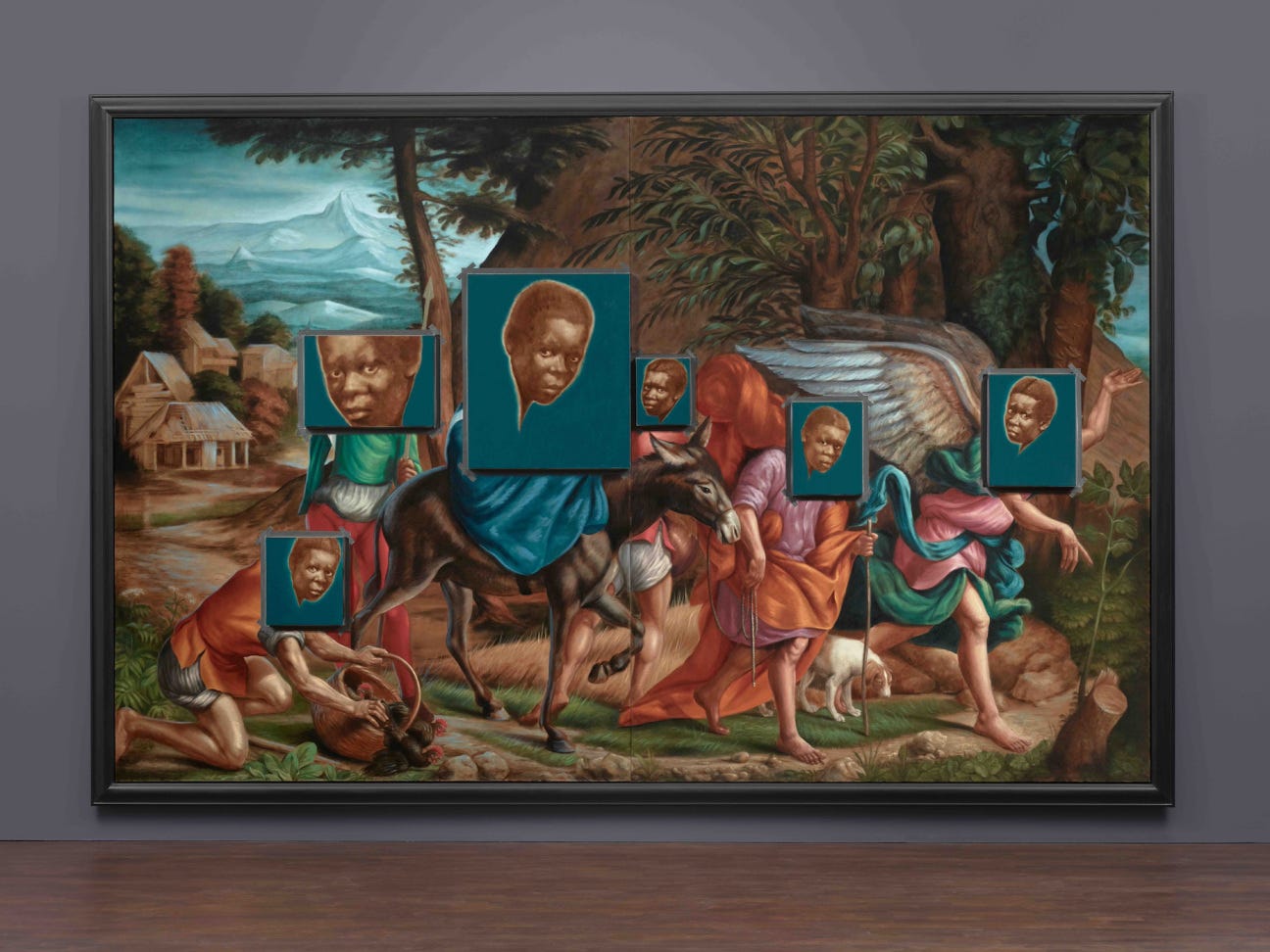
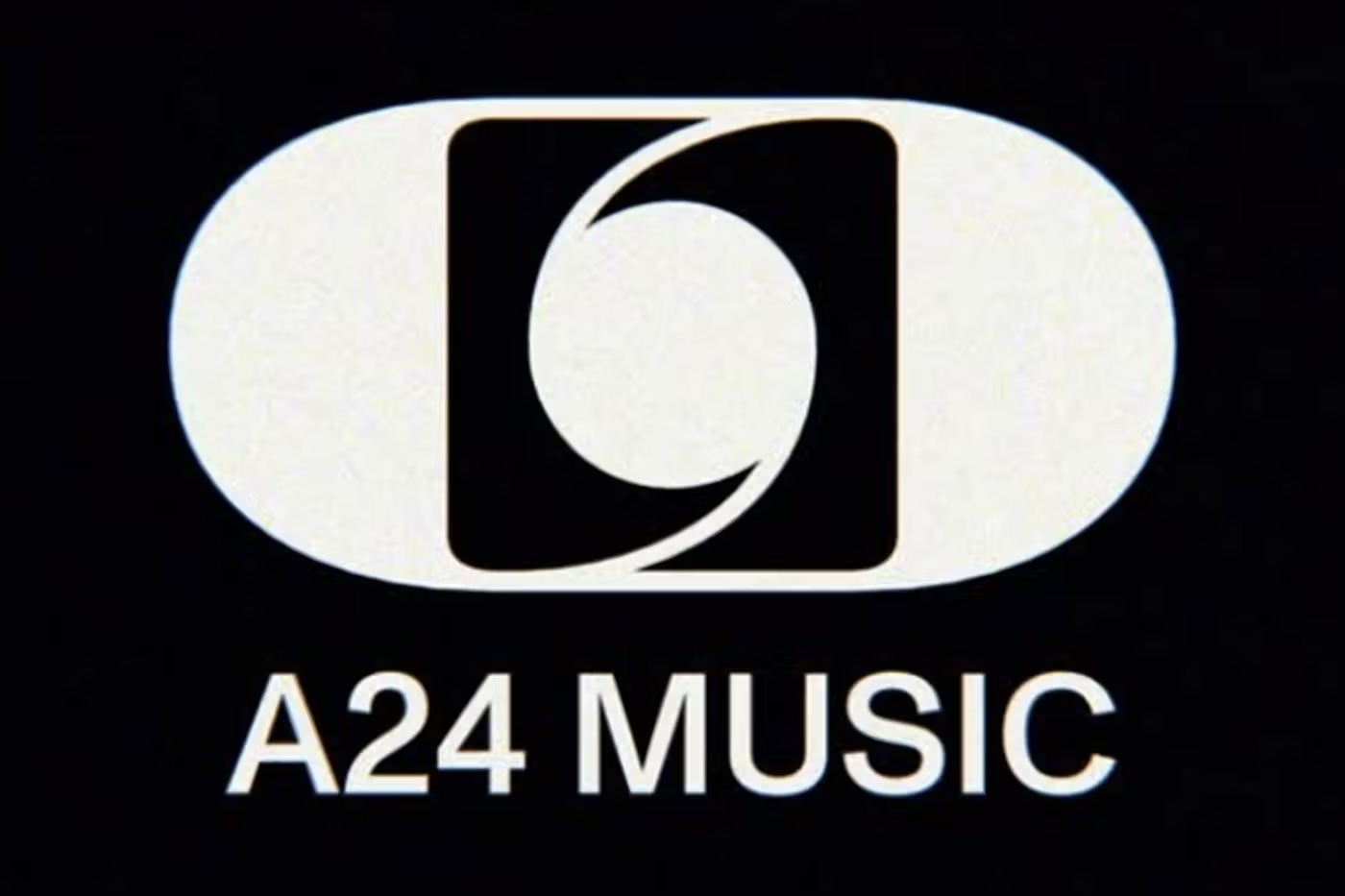

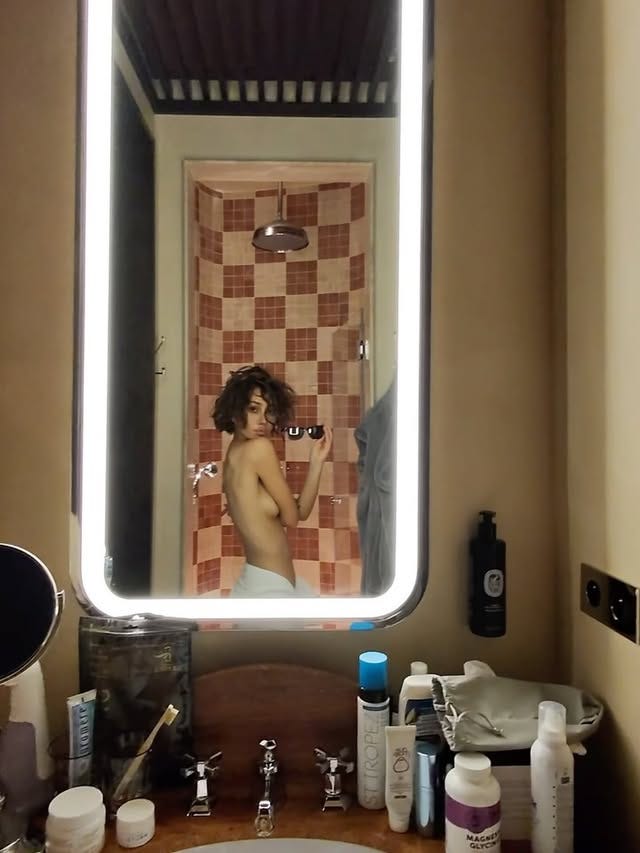
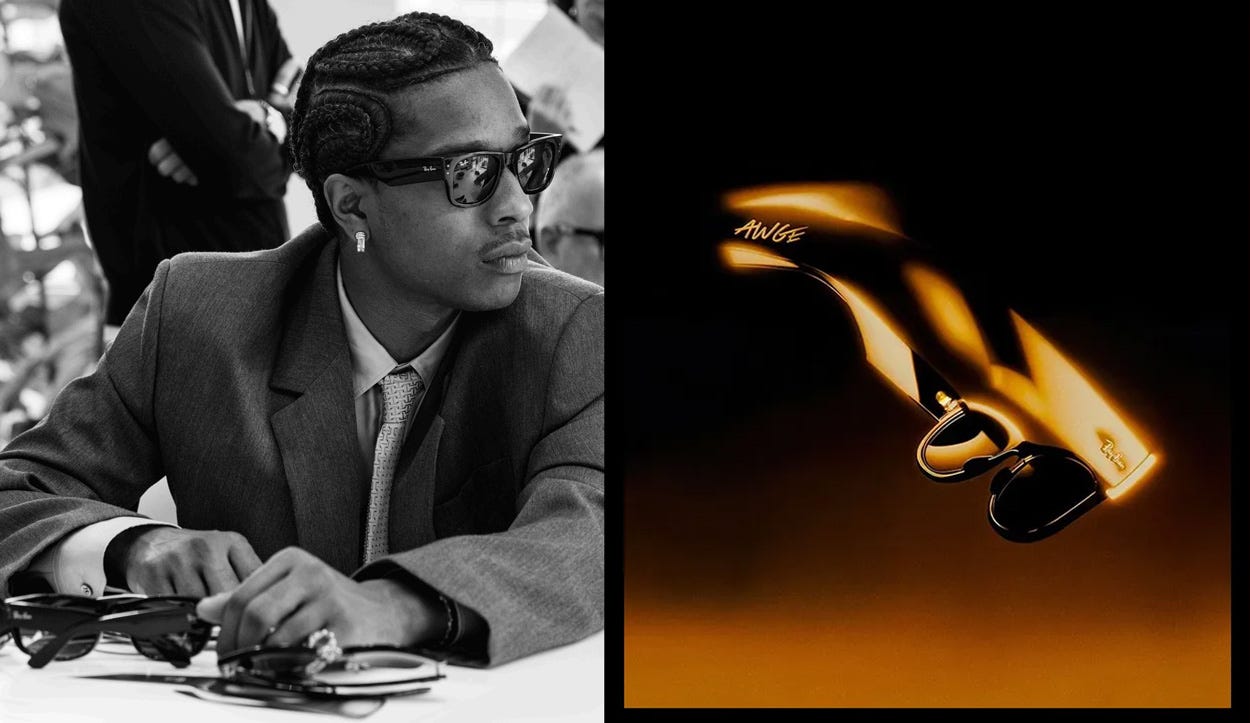
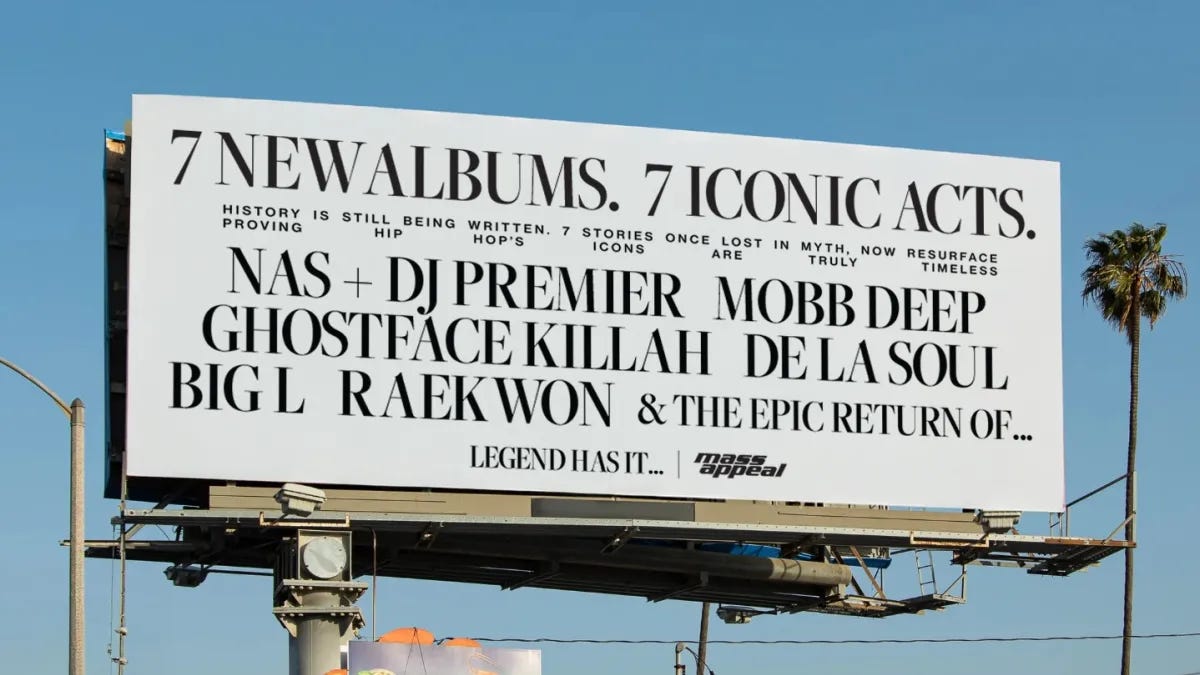
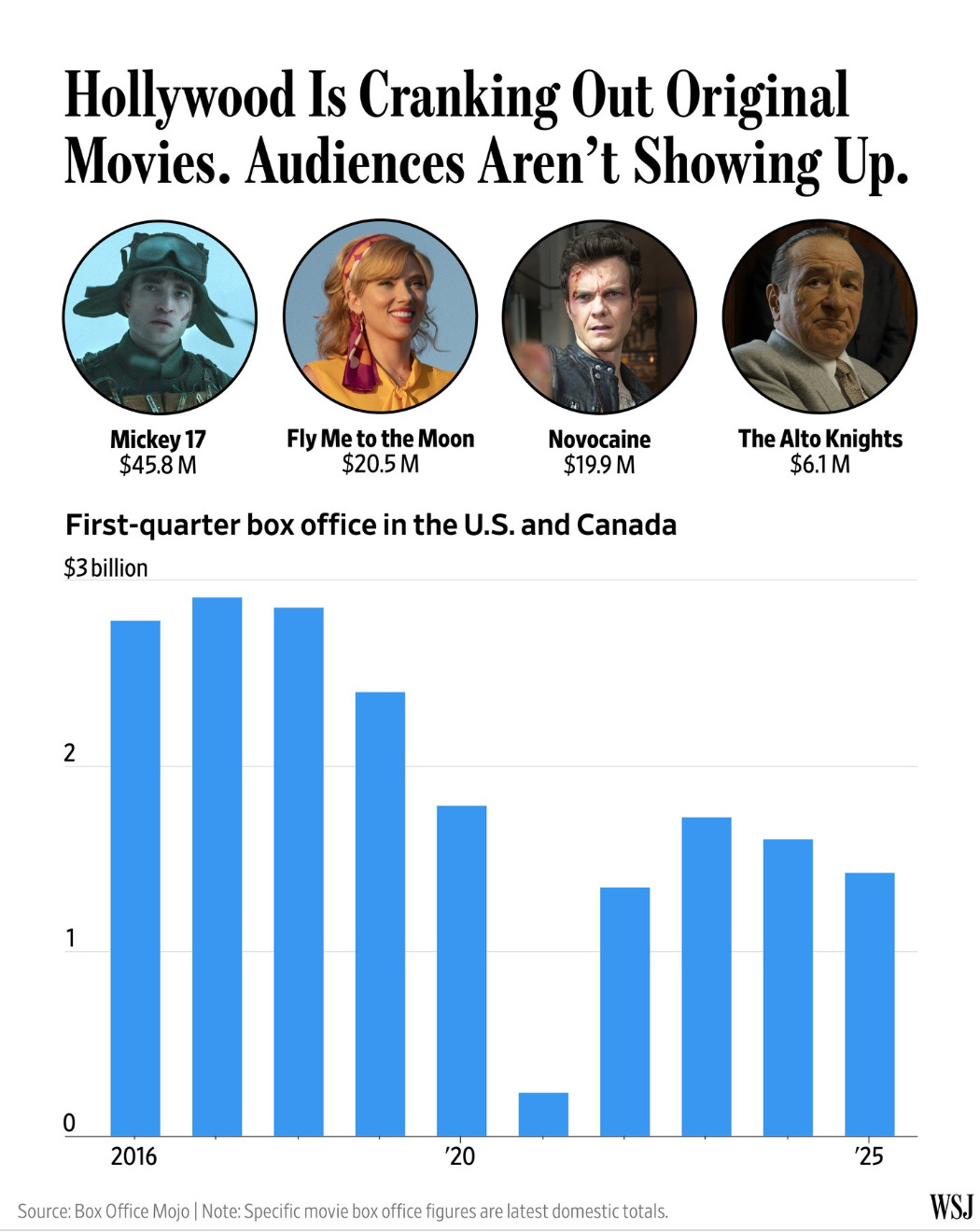
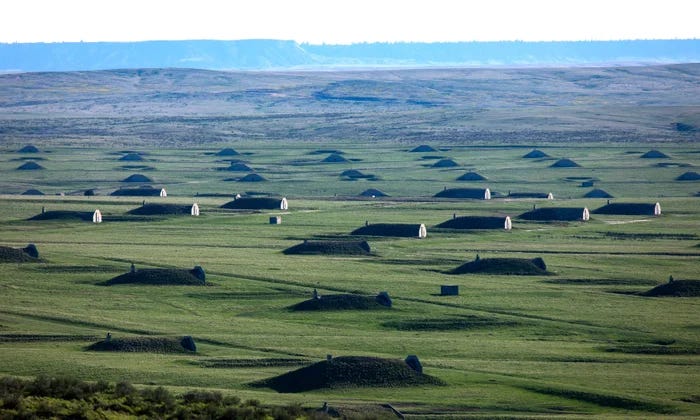
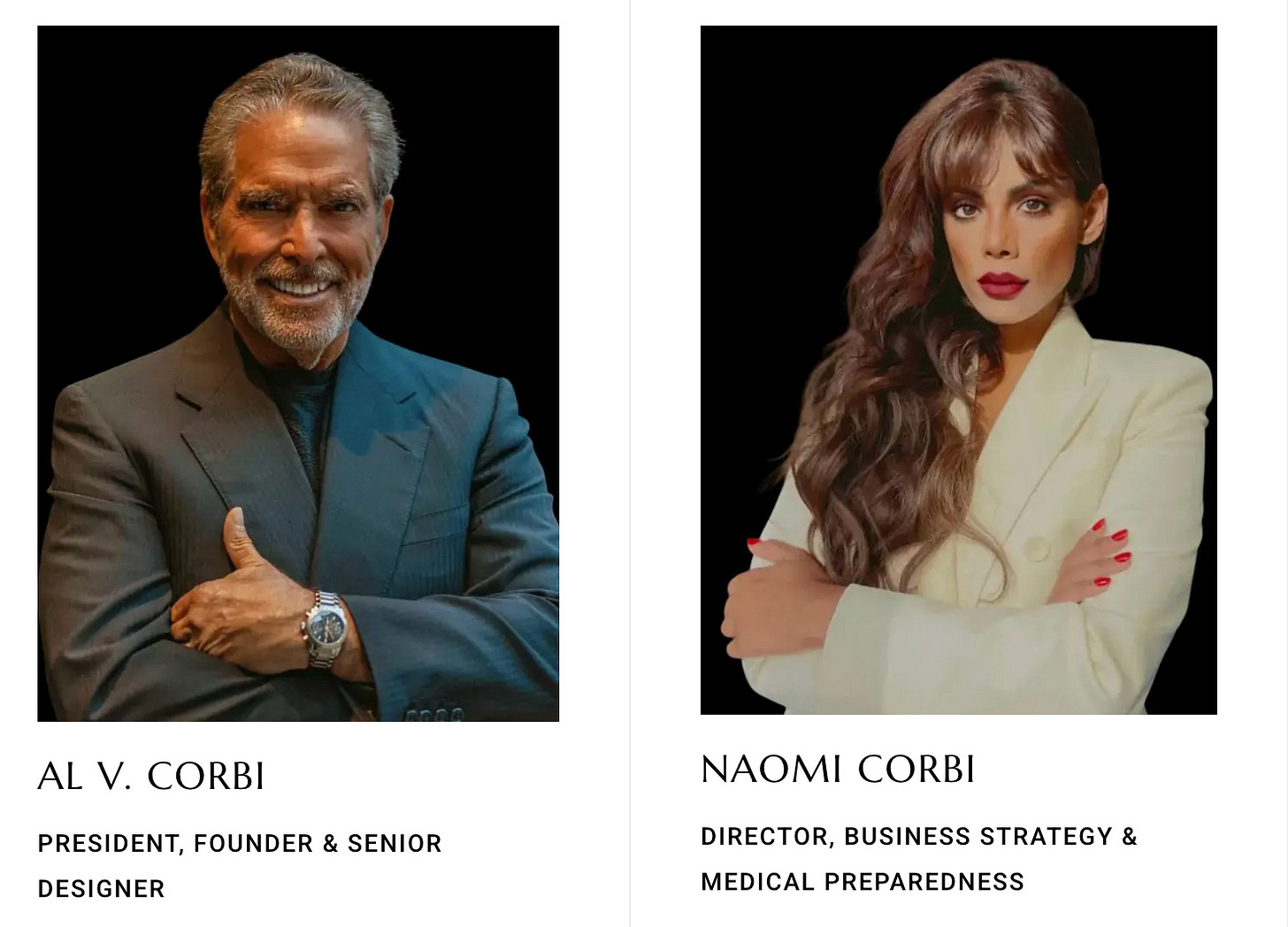
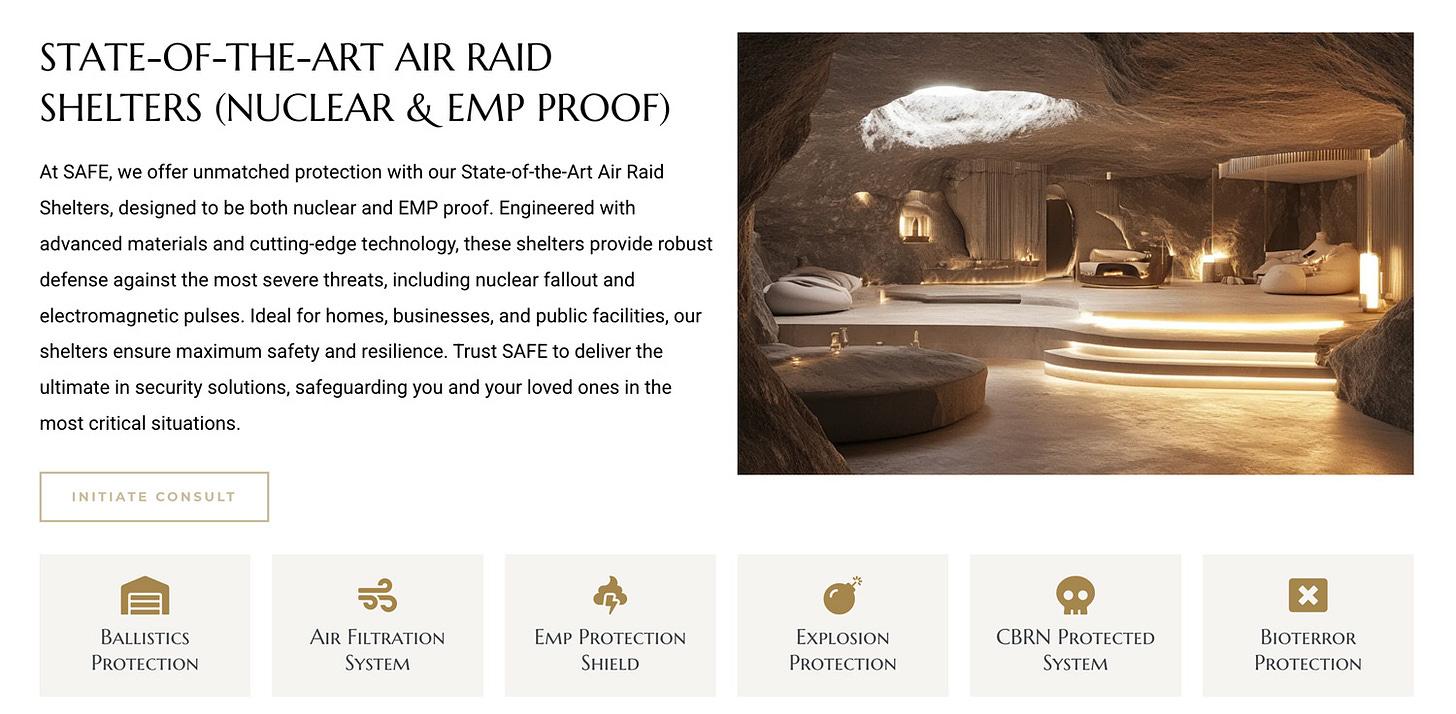

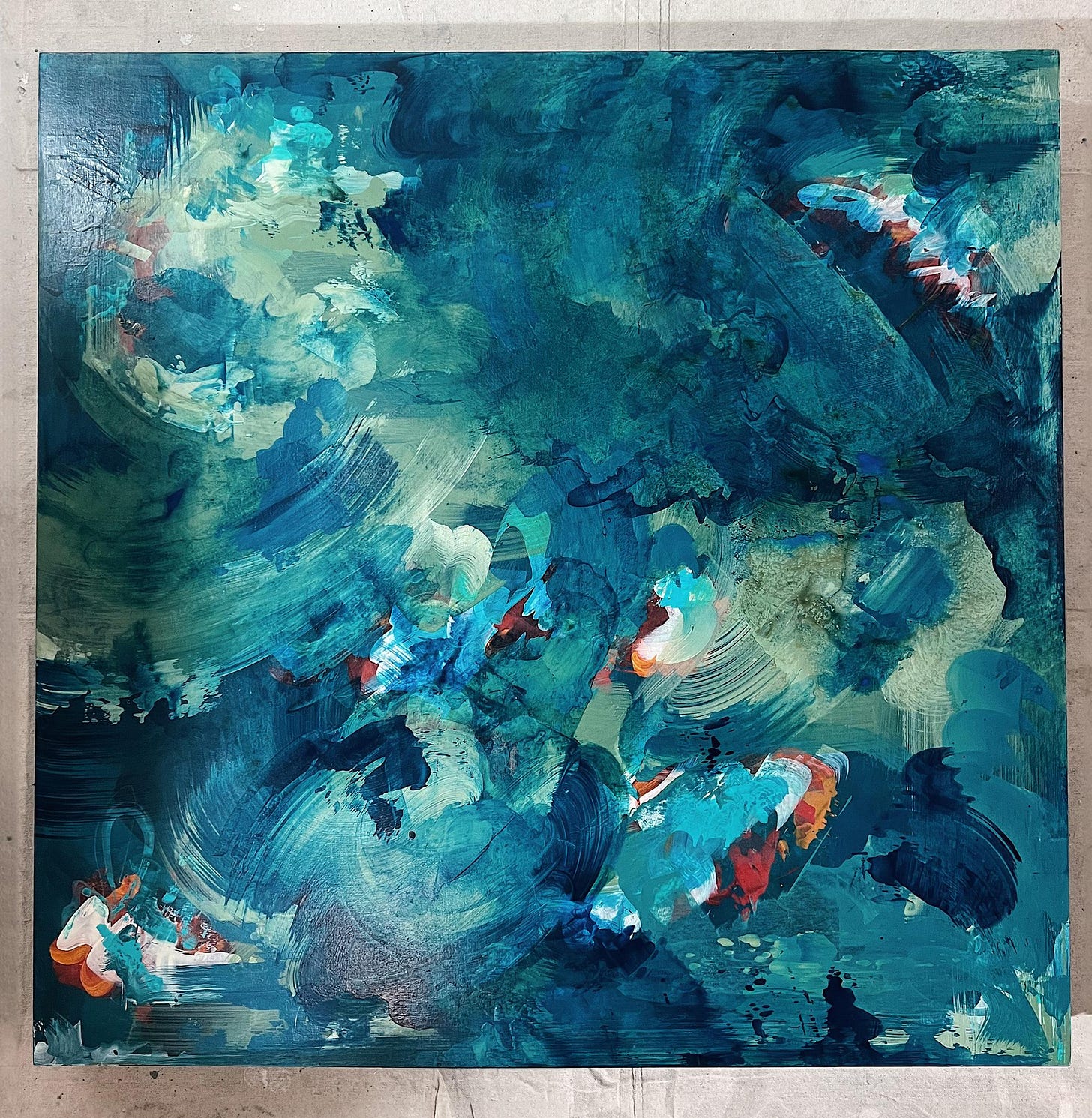

🙌 love this one
Koi revisited is alive